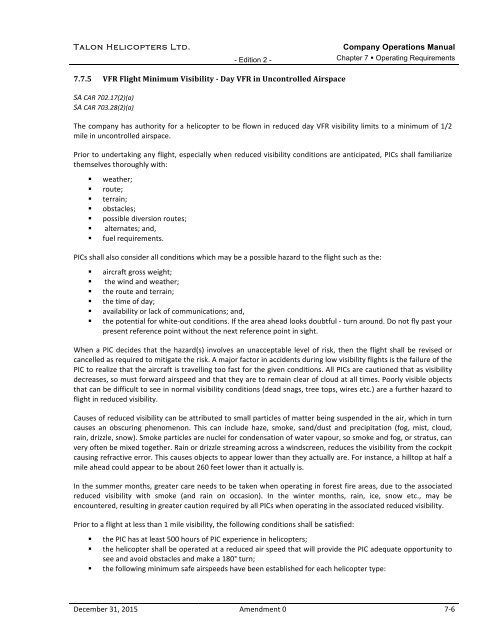Talon Helicopters Ltd COM Edition 2 Amend 0 submission 3 TC Stamped
Create successful ePaper yourself
Turn your PDF publications into a flip-book with our unique Google optimized e-Paper software.
<strong>Talon</strong> <strong>Helicopters</strong> <strong>Ltd</strong>.<br />
- <strong>Edition</strong> 2 -<br />
Company Operations Manual<br />
Chapter 7 § Operating Requirements<br />
7.7.5 VFR Flight Minimum Visibility - Day VFR in Uncontrolled Airspace<br />
SA CAR 702.17(2)(a)<br />
SA CAR 703.28(2)(a)<br />
The company has authority for a helicopter to be flown in reduced day VFR visibility limits to a minimum of 1/2<br />
mile in uncontrolled airspace.<br />
Prior to undertaking any flight, especially when reduced visibility conditions are anticipated, PICs shall familiarize<br />
themselves thoroughly with:<br />
§ weather;<br />
§ route;<br />
§ terrain;<br />
§ obstacles;<br />
§ possible diversion routes;<br />
§ alternates; and,<br />
§ fuel requirements.<br />
PICs shall also consider all conditions which may be a possible hazard to the flight such as the:<br />
§ aircraft gross weight;<br />
§ the wind and weather;<br />
§ the route and terrain;<br />
§ the time of day;<br />
§ availability or lack of communications; and,<br />
§ the potential for white-out conditions. If the area ahead looks doubtful - turn around. Do not fly past your<br />
present reference point without the next reference point in sight.<br />
When a PIC decides that the hazard(s) involves an unacceptable level of risk, then the flight shall be revised or<br />
cancelled as required to mitigate the risk. A major factor in accidents during low visibility flights is the failure of the<br />
PIC to realize that the aircraft is travelling too fast for the given conditions. All PICs are cautioned that as visibility<br />
decreases, so must forward airspeed and that they are to remain clear of cloud at all times. Poorly visible objects<br />
that can be difficult to see in normal visibility conditions (dead snags, tree tops, wires etc.) are a further hazard to<br />
flight in reduced visibility.<br />
Causes of reduced visibility can be attributed to small particles of matter being suspended in the air, which in turn<br />
causes an obscuring phenomenon. This can include haze, smoke, sand/dust and precipitation (fog, mist, cloud,<br />
rain, drizzle, snow). Smoke particles are nuclei for condensation of water vapour, so smoke and fog, or stratus, can<br />
very often be mixed together. Rain or drizzle streaming across a windscreen, reduces the visibility from the cockpit<br />
causing refractive error. This causes objects to appear lower than they actually are. For instance, a hilltop at half a<br />
mile ahead could appear to be about 260 feet lower than it actually is.<br />
In the summer months, greater care needs to be taken when operating in forest fire areas, due to the associated<br />
reduced visibility with smoke (and rain on occasion). In the winter months, rain, ice, snow etc., may be<br />
encountered, resulting in greater caution required by all PICs when operating in the associated reduced visibility.<br />
Prior to a flight at less than 1 mile visibility, the following conditions shall be satisfied:<br />
§ the PIC has at least 500 hours of PIC experience in helicopters;<br />
§ the helicopter shall be operated at a reduced air speed that will provide the PIC adequate opportunity to<br />
see and avoid obstacles and make a 180° turn;<br />
§ the following minimum safe airspeeds have been established for each helicopter type:<br />
December 31, 2015 <strong>Amend</strong>ment 0 7-6


